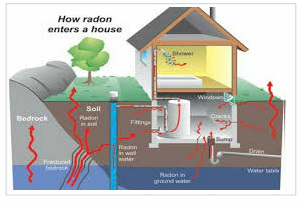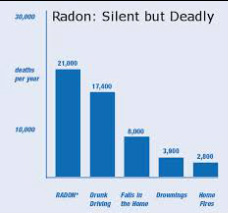Radon Testing
Servicing Southeastern Pennsylvania
Radon is the 2nd leading cause of lung cancer. Radon is a colorless, odorless, tasteless, and chemically inert radioactive gas. It is formed by the natural radioactive decay of uranium in rock, soil, and water. It can be found in all 50 states. Testing for it is the only way of telling how much is present.
More than 20,000 Americans die of radon-related lung cancer each year.
What is radon? Radon is a radioactive gas. It is colorless, odorless, tasteless, and chemically inert. Unless you test for it, there is no way of telling how much is present.
Radon is formed by the natural radioactive decay of uranium in rock, soil, and water. Naturally existing, low levels of uranium occur widely in Earth’s crust. It can be found in all 50 states. Once produced, radon moves through the ground to the air above. Some remains below the surface and dissolves in water that collects and flows under the ground’s surface.
Radon has a half-life of about four days—half of a given quantity of it breaks down every four days. When radon undergoes radioactive decay, it emits ionizing radiation in the form of alpha particles. It also produces short-lived decay products, often called progeny or daughters, some of which are also radioactive

How does radon get into a building? Most indoor radon comes into the building from the soil or rock beneath it. Radon and other gases rise through the soil and get trapped under the building. The trapped gases build up pressure. Air pressure inside homes is usually lower than the pressure in the soil. Therefore, the higher pressure under the building forces gases though floors and walls and into the building. Most of the gas moves through cracks and other openings. Once inside, the radon can become trapped and concentrated.
Openings which commonly allow easy flow of the gases in include the following:
- Cracks in floors and walls
- Gaps in suspended floors
- Openings around sump pumps and drains
- Cavities in walls
- Joints in construction materials
- Gaps around utility penetrations (pipes and wires)
- Crawl spaces that open directly into the building
Contact Us
610.256.8545
Service Areas
Chadds Ford, PA | Chester County, PA | West Chester, PA | Chester Springs, PA | Unionville, PA | Downingtown, PA | Newtown Square, PA | Coatesville, PA | Kennett Square, PA | Jennersville, PA | West Grove, PA | Wayne, PA | Phoenixville, PA | Morgantown, PA | Pottstown, PA | Gap, PA | Glen Mills, PA | Media, PA | Brookhaven, PA | Broomall, PA
These are only a few of the areas I service, if you do not see your town please give me a call!
